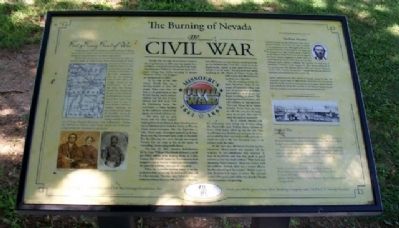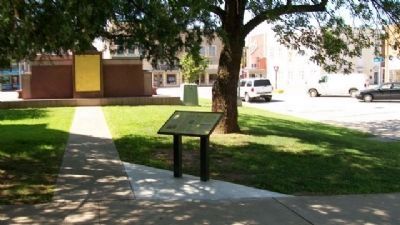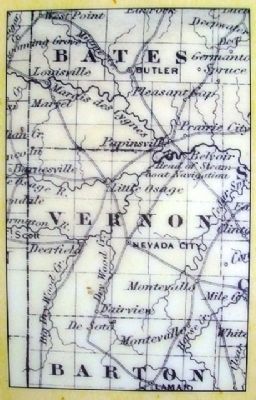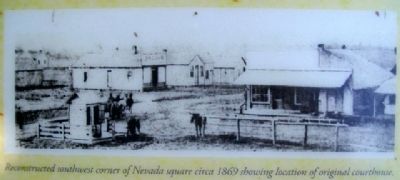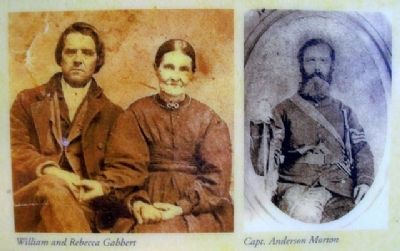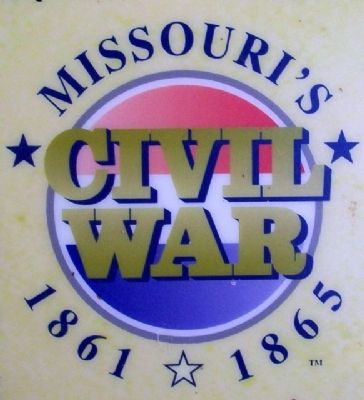Nevada in Vernon County, Missouri — The American Midwest (Upper Plains)
The Burning of Nevada
Missouri's Civil War
Nevada City was laid out as Vernon County's seat of government in 1855, and was named for a California town prominent during the Gold Rush. Founding spirit DeWitt C. Hunter had spent some years mining there before returning to western Missouri ("City" was dropped on incorporation in 1869).
At the time of the 1860 census, Nevada City was a thriving hamlet of some 450 people. Three years later, war had cut the population at least by half, leaving mostly women, children and old men. County officials had fled south with the Confederate forces. The courthouse, a frame building on the southwest corner of the square, sat locked and deserted.
The town had an early brush with war when General Sterling Price of the Missouri State Guard marched his 12,000 men north from his victory at Wilson's Creek toward Lexington, Mo. On September 2, 1861, Price's army confronted jayhawking Kansas forces over Big Drywood Creek south of Deerfield. For the following two years, though unoccupied, Nevada City lay more or less at the mercy of marauding Union and guerrilla [sic] forces.
On May 24, 1863, nineteen Bushwhackers led by Capt. William Marchbanks followed a small pro-Union militia party heading home to Cedar County, Mo., from Ft. Scott, Ks. The militiamen had stopped to rest in Nevada. Dashing in on horseback, the guerrillas [sic] scattered them and left two dead.
When the survivors reached home, a cry for retaliation went up among the militia of Cedar and St. Clair counties. Two days later, Taberville's Capt. Anderson Morton led some 100 pro-Union Missouri State Militiamen over into Vernon, meaning to wipe out the Bushwhackers "and then march on to the 'Bushwhacker capital,' as they called Nevada City, and give it to the torch." The nickname was unjust. According to The History of Vernon County, Mo (1887), none of the Bushwhackers involved was a Nevadan.
On the morning of May 26, 1863, Nevadans awoke to the sound of horsemen riding into town. At midmorning the soldiers separated into small squads and began knocking on doors. "We are going to burn this house," they told the residents, so said survivors. "Get your things out in twenty minutes. If you want any help, we will help you, but the house must be burned. This damned rebel den shall be destroyed."
By 11 o'clock, Morton and his militiamen were riding out of town along the Montevallo road. Behind them, volumes of black, thick smoke rolled up into the blue May sky. Women and children sat crying in the street, surrounded by their scattered worldly possessions. Until the end of the war Nevadans were to sit solitary amid the ashes.
At the war's end, all Vernon County lay fire-blackened, blood-stained and desolate. Of the majority of ex-Confederates who returned "it may be truthfully said that they made as good citizens as they had made soldiers." With them and incoming Union veterans, "there was neither clash nor collision. Instead, there was a mutual alliance for the rebuilding of the county." Within a year or two, business had begun to revive. The railroads came in five years, and within two decades Nevada was prosperous and growing.
hot & heavy hand of War
In burning the town, the militiamen spared the homes of Thomas Austin and James Moore, who had cared for the bodies of the two dead militiamen and promised to return them to their homes.
The day after the burning, the two men disinterred the bodies and started by wagon for Cedar County. When Austin reached the former home of one of the men, he found his house in ashes and his widow and children cowering in the bushes. In the same neighborhood they saw the smoldering ruins of other cabins and cottages burned by the Bushwhackers. On their way home after burning Nevada City, Morton and his men cut the trail of the very Bushwhackers who had burned their homes. These were a band of some 25 led by William "Old Man" Gabbert, including his own family and his inlaws the Mayfields. Among the family members were Eliza Gabbert and Ella Mayfield, two of Vernon County's adventurous "Lady Bushwhackers." Fearing they had been on a raid into Cedar County Morton ordered that none of them be left alive.
Surrounding the Gabbert house in complete surprise the militiamen left seven bushwackers dead and burned the house. Old Man Gabbert escaped on an unsaddled and unbridled horse.
Such was the neighbor-against-neighbor war of which the burning of Nevada was part - not the glamorous war of major battlefields and immortal warriors, but the gritty, sordid, suffering war of ordinary folk caught in a storm as inexplicable to them as a whirlwind.
DeWitt Hunter
DeWitt C. Hunter built the first house in what would become Nevada, he named the town (a tribute to his experience in the 1849 gold rush) and he was the town's first postmaster. At the beginning of Missouri's Civil War, Hunter raised a regiment for the Missouri State Guard and went on to fight for the South. Hunter's regiment of cavalry was on a reconnaissance mission when they ran into Gen. Nathaniel Lyon's infantry on Bloody Hill, signaling the beginning of the Battle of Wilson's Creek, August 10, 1861. Hunter would go on to command the 11th Missouri Infantry, CSA, and Hunter's Missouri Cavalry, CSA. A lawyer, he returned to Nevada after the war where he practiced and continued his role in public life.
Hunter performed one other service to Nevada during the war. As incumbent county clerk, in 1862
Hunter visited the area and spirited away the county records in a Confederate army wagon. Vernon County is as a result one of the few counties on the Missouri-Kansas border that has property and probate records that precede the war.
Erected 2009 by Missouri's Civil War Heritage Foundation, Inc., Metz Banking Company and I.M.P.A.C.T. Nevada Tourism.
Topics and series. This historical marker is listed in these topic lists: Patriots & Patriotism • Settlements & Settlers • War, US Civil. In addition, it is included in the Missouri’s Civil War series list. A significant historical month for this entry is May 1967.
Location. 37° 50.318′ N, 94° 21.458′ W. Marker is in Nevada, Missouri, in Vernon County. Marker is on Main Street near Cherry Street, on the right when traveling north. Marker is on the west grounds of the Vernon County Courthouse. Touch for map. Marker is in this post office area: Nevada MO 64772, United States of America. Touch for directions.
Other nearby markers. At least 8 other markers are within walking distance of this marker. William Joel Stone (a few steps from this marker); Nevada - Vernon County Centennial (a few steps from this marker); Vernon County Courthouse (within shouting distance of this marker); Vernon County War Memorial (within shouting distance of this marker); Vernon County Valor (about 400
feet away, measured in a direct line); Vernon County's Southern Heritage (about 400 feet away); Bushwhacker Museum (about 600 feet away); The Battle of Drywood (about 600 feet away). Touch for a list and map of all markers in Nevada.
Also see . . .
1. Nevada Then [In the 19th century]. (Submitted on August 11, 2010, by William Fischer, Jr. of Scranton, Pennsylvania.)
2. James "Pony" Hill. (Submitted on August 11, 2010, by William Fischer, Jr. of Scranton, Pennsylvania.)
3. Tri-County Genealogical Society. (Submitted on August 11, 2010, by William Fischer, Jr. of Scranton, Pennsylvania.)
Credits. This page was last revised on June 16, 2016. It was originally submitted on August 8, 2010, by William Fischer, Jr. of Scranton, Pennsylvania. This page has been viewed 2,722 times since then and 118 times this year. Photos: 1, 2, 3, 4, 5, 6. submitted on August 11, 2010, by William Fischer, Jr. of Scranton, Pennsylvania.
